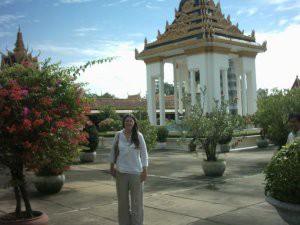 |
Sarah and I visit the capital of Cambodia, Phnom Penh.
Our first stop is a visit to the Royal Palace. |
| The Throne hall.
The Silver Pagoda is so named, as the floor is made from 5329 silver tiles. |
 |
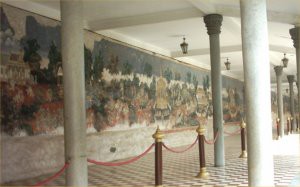 |
One of many beautifully painted wall Mural’s. |
| A house on the palace grounds, built in a French style, and reminiscent of Louisiana. |
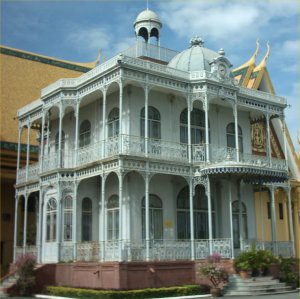 |
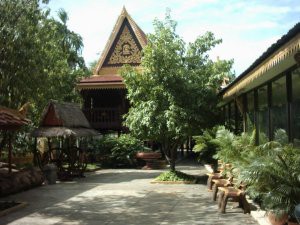 |
The grounds were varied, and included museums showing exhibits of farming and house building techniques.
We wandered around for several hours, and then had a break in the coffee shop. |
| After this, we visit the Raung Damrei National Museum.
A traditional Hindu symbol is one of the many artifacts on the grounds outside the Museum. |
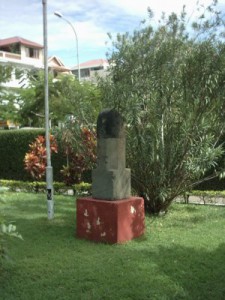 |
 |
The front of the museum.
It was not possible to take pictures inside the museum.
We had a specialist Museum guide, who talked us through the hundreds of different artifacts and Buddha statues throughout the ages. |
| In the middle of the museum was a beautiful and well maintained garden.
I never normally give to beggars, which is hard, as I know sometimes the money I pay for a newspaper in the UK, could feed them for 2 days.
This isn’t because I am tight. I contribute a lot to charity, but I believe we should help people so that they can help themselves, and encourage them to earn money instead.
As we left the museum, A street hawker was selling postcards. His hands had been blown off during the war.
After we bought some cards, he insisted on giving us our change, which we had to force him to accept as a tip.
On another occasion, we gave some small change to a child in the street, and were mobbed by around 20 children as we attempted to get into our car. |
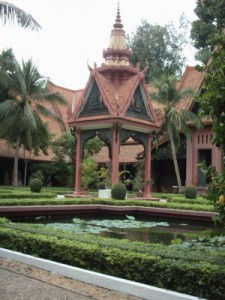 |
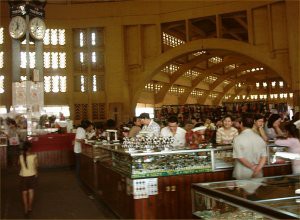 |
Our guide took is to the central Market.
It was much more formal and organized than any of the markets we had visited in Vietnam. |
| He advised us there were better bargains at the Russian Market.
We wandered around for hours, and bought loads of nice things for our new house.
In the evening, we visited the internationally famous Foreign Correspondents club, next to Sisowath key on the Tonle Sap River.
Supposedly, everyone who is anyone in Cambodia, goes there. The food was excellent, and at one point the power to the building failed, which was exciting. |
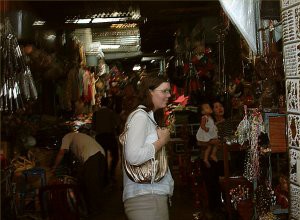 |
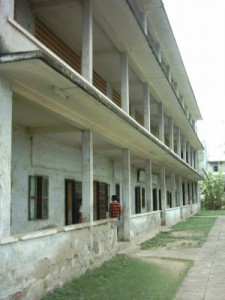 |
Cambodia, was a contrast of some of the most beautiful sights I had ever seen, and some of the most horrible.
Here we visit the Toul Sleng museum of genocide used by S-21 to carry out the orders of Pol Pot, who came to power on the 17/4/75.
The “lucky” one’s were marched of to the fields and forced to work 12 – 14 hours per day. The rest ended up here.
It had once been a high school, it was used for interrogation and torture. |
| Some things there, I didn’t photograph, as they were frankly too horrible to be put on a public site.
Here a cell where “prisoners” would spend 3 days of torture and interrogation, before being executed as a matter of course.
The “prisoner” would be chained naked to the bed. They would sometimes be given an empty oil container as a water bottle, and an ammunition box to be used as a toilet.
There was dried blood on the floor from where several people had been executed. |
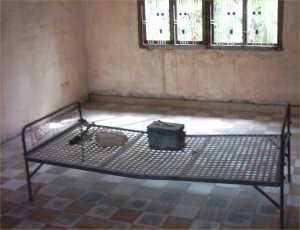 |
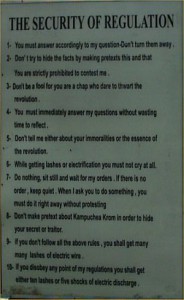 |
Interrogation was conducted to find out if people were intellectuals or had committed crimes against the state.
In reality, whatever they said, they were executed after 3 days.
The Khmer Rouge routinely photographed each person before execution and in one of the rooms, their pictures had been put on display.
The cruelty of the interrogators new no bounds.
One picture showed a woman just before she was executed.
She had pleaded for her 2 month old babies life with no regard for herself.
In reply, they killed the baby first. In front of her. |
| As a backlog developed, more and more cells were created to house the enormous number of “criminals”.
Most of the “guards” and interrogators, were armed children aged between 10 and 15.
They had been taken away from their parents and indoctrinated. |
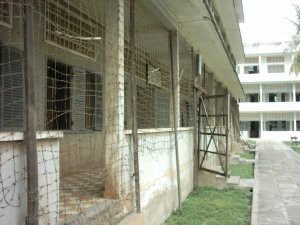 |
 |
The grounds were varied, and included museums showing exhibits of farming and house building techniques.
We wandered around for several hours, and then had a break in the coffee shop. |
| After having lunch at the foreign correspondents club, we cautiously headed 9 miles out of town to Choeung Ek.
There are actually thousands of sites like this in Cambodia, but this is the one that most people associate with the Killing Fields.
Our guide had been lucky enough to be educated in Europe (his English was superb.) and had avoided much of his countries tragedy’s.
His Grandfather had been killed by the Khmer rouge, and his father had been killed in the Vietnamese invasion. |
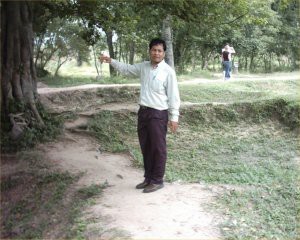 |
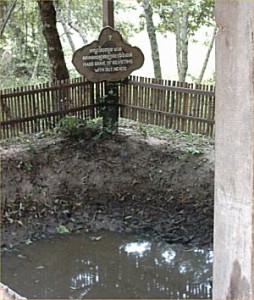 |
There were ditches everywhere, where bodies had been dumped.
If a person was found to be still alive, they would be hanged from one of the nearby tree’s to save ammunition.
Although a great effort had been made to remove the bodies, there were bone remnants, literally everywhere you walked.
On rainy days, bones are washed onto the path.
In this ditch, 166 bodies of people without heads, were retrieved. |
| Some years ago, I watched a documentary about the killing fields.
Children had been swung by their feet against a tree, and had there heads smashed in, to save ammunition.
At the site, I recognized the tree. astoundingly, a small child offered to be photographed next to it.
Its in the far background, I couldn’t bring myself to stand near it, let alone photograph it. |
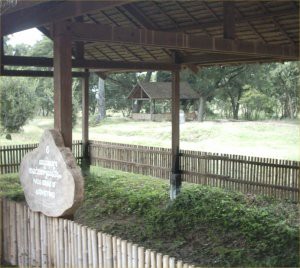 |
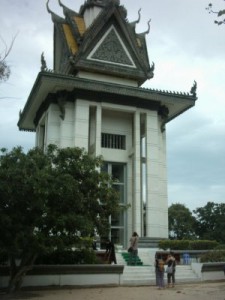 |
The monument containing the remains of 20,000 victims next to the field.
People were executed because they spoke French, because they wore spectacles, because they looked “clever” and even if they showed remorse when loved ones were being taken away.
A third of the countries population were killed (figures vary between 2 and 3 million dead). Children killed their “criminal” parents with shovels.
In 1979, the Vietnamese invaded Cambodia. 10,000,000 land mines were left behind (there are still 1,000,000 to this day) and 600,000 people fled across the Thai Border.
In 1991 the UN launched the largest peacekeeping mission in history to restore democracy in Cambodia.
In 1998 Pol Pot died in his home under house arrest. |
| Cambodia has a long way to go to get back to normal, but hope exists everywhere.
One our way home, we passed the football stadium.
Our guide commented that in a friendly game against Vietnam, they had been beaten 8 – 0. I replied that wasn’t a great result.
He said the same football stadium had been a holding area for “criminals” before being moved to Toul Sleng.
Most Cambodians, were delighted just to see football actually being played there. |
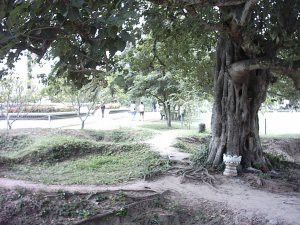 |